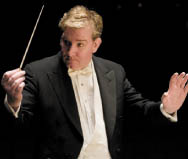|
Symphony
MYSTICAL PLANETS AND LIVELY GERSHWIN ORTIZ AT FINAL SRS CONCERT
by Peter Lert
Sunday, May 4, 2025
Symphony
VSO'S CONCERT MUSIC OF TIME, MUSIC OF PLACE
by Peter Lert
Sunday, April 27, 2025
Choral and Vocal
VOCAL ELEGANCE AND FIRE AT THE 222'S RECITAL APRIL 26
by Pamela Hicks Gailey
Saturday, April 26, 2025
CANTIAMO SONOMA SINGS AN INSPIRED GOOD FRIDAY MOZART REQUIEM CONCERT
by Pamela Hicks Gailey
Friday, April 18, 2025
DRAMATIC SHOSTAKOVICH SYMPHONY CLOSES PHILHARMONIC'S 25TH SEASON
by Terry McNeill
Sunday, April 13, 2025
LARGE COLLEGE OF MARIN AUDIENCE GREETS STOPHER ARTISTRY
by Terry McNeill
Saturday, April 5, 2025
Chamber
FRISSON DELIVERS SHIVERS OF DELIGHT
by Abby Wasserman
Sunday, March 30, 2025
OLD AND MOSTLY NEW IN SRS MARCH CONCERT IN WEILL
by Peter Lert
Saturday, March 22, 2025
Symphony
TWO FORMIDABLE SYMPHONIES AND PURPLE MOUNTAINS AT SRS CONCERT
by Peter Lert
Sunday, February 23, 2025
Chamber
THE PARKER CAPTURES DEMANDING ADES QUARTET AT RAC SEBASTOPOL CONCERT
by Peter Lert
Saturday, February 15, 2025
|
 |
 Conductor Alasdair Neale |
PROPULSIVE BERLIOZ AND CONSUMMATE CONDUCTOR STAR AT MARIN SYMPHONY
by Terry McNeill
Tuesday, September 30, 2014
It’s not an easy task to upstage the virtuoso cellist Zuill Bailey, but Marin Symphony conductor Alasdair Neale did it convincingly in a Sept. 30 concert at the Marin Center Auditorium.
Mr. Bailey didn’t easily relinquish the starring role and played an eloquent and urbane performance in St. Saëns’ First Concerto, Op. 33, from 1872. For Mr. Bailey, a North Coast favorite, it was a surprisingly low temperature performance that had fast tempos and at times a legato that blurred scale passages. In the Allegretto the cellist displayed a deft pianissimo, spicatto bowing and even trills. In the finale both Mr. Neale and Mr. Bailey adopted a restrained approach to this mellifluous music that showcased a long thematic line that was everywhere reminiscent of the composer’s Introduction and Rondo for Violin and Orchestra, written nine years before the Concerto.
Timing in the short first half generated a crowd-pleasing encore, and not for this soloist was the usual movement from a Bach unaccompanied Suite. It was the captivating five-minute Intermezzo entr’acte from Massenet’s opera Thaďs. Here Mr. Bailey broadened his vibrato and played the lovely melody seamlessly merging with the Marin musicians and especially harpist Don Leviton. At the end the motionless Mr. Neale held the audience in a fermata, letting the magical silence play out for 15 seconds.
Following intermission the Symphony unleashed a demonic performance of Berlioz’ Symphonie Fantastique, guided by the conductor’s conception of a sonic extravaganza. This hall has a direct sound with little reverberation, seemingly favoring in this work the lower frequencies of six basses and eight cellos. All through the five-movement symphony that lasted just short of an hour the conductor relished moderate tempos, never rushing in voice leadings to the big climaxes. And there were many big climaxes.
In the lovely waltzes of the second movement Mr. Neale eschewed big ritards and elastic rhythms, emphasizing instead strict rhythms, section balances and tonal richness. Clarinetist Arthur Austin and flutist Monica Daniel-Barker played fetching duos.
For me the instrumental highlight of the evening was the delicate and haunting English horn solos that began the “Scene in the Fields” movement. Laura Reynolds was the performer in music that Wagner clearly knew when he composed the equally haunting Prelude to Act III of “Tristan und Isolde.” The wind choir and violas played wonderfully. Mr. Neale’s control and concentration was complete and only sporadically did he look at the score. The string pizzicato playing in the March to the Scaffold movement was telling, as was the sonority of chimes, tuba (two of them, and two harps!) trombones and bassoon in the Dies Irae theme of the Witches Sabbath conclusion. Mr. Neale gave each repeat a slightly different character that lent novel interest to this propulsive and raucous movement. A standing ovation followed the final tumultuous chords, and it was surely a tribute to both orchestra’s playing and the conductor’s bold conception and consummate control of Berlioz’ sprawling composition.
The concert opened with Bernstein’s Overture to the operetta “Candide,” fast and with trumpets blaring. With the stage packed with performers, many more than were needed in the St. Saëns Concerto, the performance of this popular concert opener was swift, muddy in texture and actually too loud.
|
